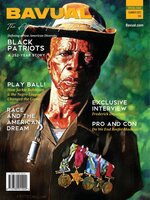Taking its name from the Swahili word for powerful, BAVUAL documents the African experience from the begining of recorded history to the present. Each issue features essays, historical profiles, and interviews which tell the story of 680 centuries of Afrocentric progress, and how these stories relate to today’s world.
BAVUAL, The African Heritage Magazine
Coming to America, or Why I Am Strongly Pro-Immigrant • From the Editor and Publisher
15 Renowned Black Architects Shaped the American Landscape • These 15 men and women are the African counterpoint to Frank Lloyd Wright, I.M. Pei and Le Corbusier, the troika of modern architecture, and their influence and beautiful designs can be seen in our homes, our workplaces, our schools, our churches, our entertainment venues, our communities. Many have been trained—and continue to be trained—at Tuskegee University’s (formerly Tuskegee Institute) prestigious architectural department. Architecture and building trade skills were nurtured in slavery and blossomed after the Civil War, when architecture became a key profession for black professionals. Sadly, much of their early work has been lost or destroyed. The structures that remain are a testament to their creative genius.
Subscribe to BAVUAL
Christian Smalls • Amazon Union Activist
YEARS OF CHANGE 1961-1967 • The push for desegregation and civil rights became a nonstop priority for the black community during the 1960s. Youth participation in civil rights efforts became prevalent during this decade as the Student Nonviolent Coordinating Committee (SNCC) emerged and strove to desegregate public facilities and register black voters. While many African Americans began to embrace their African heritage and develop a sense of black culture and identity, many others became exhausted with the harsh treatment and unattainable standards they faced from white society.
Just Another Pawn in the Game • Russia’s Political Prisoner
Subscribe to BAVUAL
A 252-YEAR STORY • A Photo Essay
Should Marijuana Be Legalized? • How did marijuana become Public Enemy No. 1? Like most things in America, the problem is rooted in racism and xenophobia.
How Race Has Shaped The American Dream • Homeownership has always been the gold standard for Americans. While presented as a normative outcome following the completion of school or landing a dream job, it has been elusive for African Americans. This elusive nature is closely related to structural barriers of race and discrimination that are deeply rooted in a long history that can be traced back to the 19th century and that evolved and intensified in the 20th century. These realities have left us with the problematic legacy we have inherited today—a legacy of racial discrimination that has destroyed the dreams of many individuals and deflated the wealth potential of generations of African Americans.
Levittown, Pa., 1957: Sad, Inspiring Case of the Myers Family
The Trumps: The Face of Racism in Housing
GOING UPTOWN TO HARLEM
ON BEING BLACK AND LGBTQIA+ • Being seen as “different” in a country that has little to no tolerance for difference is a hard task in itself. Add to that the fact that you are of a race that is often discriminated against, and you have a difficult situation to deal with on a daily basis. This is a position that many Americans face being black and identifying as a member of the LGBTQIA+ community. Although a scary place to be at times, throughout history African Americans have led the march for equality, while facing disapproval, hatred and sometimes violence and death. Racism combined with the forces of stigma, phobia, discrimination and bias associated with gender and sexuality have too often erased the contributions of people of color.
Homosexuality: Nature or Nurture?
The Players Who Changed the...

 Fall 2022
Fall 2022
 Summer 2022
Summer 2022
 Spring 2022
Spring 2022